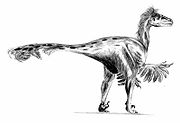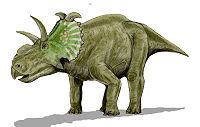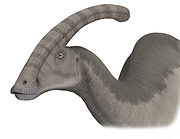
Oldman Formation
Encyclopedia
The Oldman Formation is the middle member of the Judith River Group
, a major geologic unit in southern Alberta
. The formation is widely recognized as bearing a great number of well preserved dinosaur skeletons, as well as other fossils.
, between 77.5 and 76.5 million years ago.
below and the Dinosaur Park Formation
above. It lies fully within Chron 33n
.
Judith River Group
The Judith River Group is a group of geologic formations in western North America dating from the late Cretaceous and noted as a site for the extensive excavation of dinosaur fossils. The formation is named after the Judith River in Montana. The group is also called the Judith River Wedge...
, a major geologic unit in southern Alberta
Alberta
Alberta is a province of Canada. It had an estimated population of 3.7 million in 2010 making it the most populous of Canada's three prairie provinces...
. The formation is widely recognized as bearing a great number of well preserved dinosaur skeletons, as well as other fossils.
Age
The Oldman Formation was deposited during the middle CampanianCampanian
The Campanian is, in the ICS' geologic timescale, the fifth of six ages of the Late Cretaceous epoch . The Campanian spans the time from 83.5 ± 0.7 Ma to 70.6 ± 0.6 Ma ...
, between 77.5 and 76.5 million years ago.
Relationship to other units
The formation is bounded by the Foremost FormationForemost Formation
The Foremost Formation is a geological formation in Alberta, Canada whose strata date back to the Late Cretaceous. Dinosaur remains are among the fossils that have been recovered from the formation.-Dinosaurs:...
below and the Dinosaur Park Formation
Dinosaur Park Formation
The Dinosaur Park Formation is the uppermost member of the Judith River Group, a major geologic unit in southern Alberta. It was laid down over a period of time between about 76.5 and 75 million years ago. The formation is made up of deposits of a high-sinuosity fluvial system, and is capped...
above. It lies fully within Chron 33n
Polarity chron
A Polarity Chron, or chron, is a term used in stratigraphy to name the time interval represented by a magnetostratigraphic polarity unit. It represents a certain time period in geologic history where the Earth's magnetic field was in a "normal" and "reversed" position. Chrons are numbered in order...
.
Theropods
| Theropods reported from the Oldman Formation | ||||||
|---|---|---|---|---|---|---|
| Genus | Species | Location | Stratigraphic position | Material | Notes | Images |
Daspletosaurus Daspletosaurus Daspletosaurus is a genus of tyrannosaurid theropod dinosaur that lived in western North America between 77 and 74 million years ago, during the Late Cretaceous Period. Fossils of the only named species were found in Alberta, although other possible species from Alberta and Montana await... |
D. torosus |
Upper through lower |
Several specimens |
A tryannosaurid |
   |
|
Dromaeosaurus Dromaeosaurus Dromaeosaurus was a genus of theropod dinosaur which lived during the Late Cretaceous period , sometime between 76.5 and 74.8 million years ago, in the western United States and Alberta, Canada. The name means 'running lizard'.... |
Indeterminate |
Teeth |
A dromaeosaurid |
|||
Dromiceiomimus |
D. brevitertius |
Misreported |
||||
Elmisaurus Elmisaurus Elmisaurus is an extinct genus of dinosaur from the Late Cretaceous. It was a theropod belonging to the Oviraptorosauria. Its fossils have been found in Asia and North America. It is known from only its feet and hands.... |
E. elegans |
Misreported, found in the Dinosaur Park Dinosaur Park Formation The Dinosaur Park Formation is the uppermost member of the Judith River Group, a major geologic unit in southern Alberta. It was laid down over a period of time between about 76.5 and 75 million years ago. The formation is made up of deposits of a high-sinuosity fluvial system, and is capped... , Hell Creek Hell Creek Formation The Hell Creek Formation is an intensely-studied division of Upper Cretaceous to lower Paleocene rocks in North America, named for exposures studied along Hell Creek, near Jordan, Montana... , and Two Medicine Formation Two Medicine Formation The Two Medicine Formation is a geologic formation, or rock body, that was deposited between 83.5 ± 0.7 Ma to 70.6 ± 0.6 Ma , during Campanian time, and is located in northwestern Montana... s |
||||
Hesperonychus Hesperonychus Hesperonychus was a genus of small, carnivorous dromaeosaurid dinosaur. There is one described species, Hesperonychus elizabethae; the type species was named in honor of the woman who collected it in 1982... |
H. elizabethae |
Foot claw |
A dromaeosaurid |
|||
Paronychodon Paronychodon Paronychodon was a theropod dinosaur genus. It is a tooth taxon, considered dubious because of the fragmentary nature of the fossils, which include "buckets" of teeth but no other remains... |
Indeterminate |
Teeth |
A troodontid |
|||
Ricardoestesia Ricardoestesia Richardoestesia is a medium-sized genus of theropod dinosaur from the late Cretaceous Period of what is now North America. It is known from a single pair of lower jaw bones and a large number of isolated teeth.... |
R. isosceles |
Misreported |
||||
Indeterminate |
Teeth |
A dromaeosaurid |
||||
Saurornitholestes Saurornitholestes Saurornitholestes is a genus of carnivorous dromaeosaurid theropod dinosaur from the late Cretaceous of Alberta, Montana and New Mexico.... |
S. langstoni |
Partial remains |
A dromaeosaurid |
|||
Troodon Troodon Troodon is a genus of relatively small, bird-like dinosaur from the Late Cretaceous period . Discovered in 1855, it was among the first dinosaurs found in North America... |
T. formosus |
Teeth, eggs, embryos |
A troodontid, also found in the Dinosaur Park Dinosaur Park Formation The Dinosaur Park Formation is the uppermost member of the Judith River Group, a major geologic unit in southern Alberta. It was laid down over a period of time between about 76.5 and 75 million years ago. The formation is made up of deposits of a high-sinuosity fluvial system, and is capped... , Judith River Judith River Formation The Judith River Formation is a fossil-bearing geologic formation in Montana, and is part of the Judith River Group. It dates to the upper Cretaceous, between 80 and 75 million years ago, corresponding to the "Judithian" land vertebrate age... , Lance Lance Formation The Lance Formation is a division of Late Cretaceous rocks in the western United States. Named after Lance Creek, Wyoming, the microvertebrate fossils and dinosaurs represent important components of the latest Mesozoic vertebrate faunas... , and Two Medicine Formation Two Medicine Formation The Two Medicine Formation is a geologic formation, or rock body, that was deposited between 83.5 ± 0.7 Ma to 70.6 ± 0.6 Ma , during Campanian time, and is located in northwestern Montana... s |
|||
Ornithischians
| Ornithischians reported from the Oldman Formation | ||||||
|---|---|---|---|---|---|---|
| Genus | Species | Location | Stratigraphic position | Material | Notes | Images |
Albertaceratops Albertaceratops Albertaceratops was a genus of centrosaurine horned dinosaur from the middle Campanian-age Upper Cretaceous Oldman Formation of Alberta, Canada.... |
A. nesmoi |
Lower |
A ceratopsid |
    |
||
Anchiceratops Anchiceratops Anchiceratops is a genus of chasmosaurine ceratopsid dinosaur from the Late Cretaceous Period of western North America. Like other ceratopsids, it was a quadrupedal herbivore with three horns on its face, a parrot-like beak, and a long frill extending from the back of its head. The two horns above... |
Indeterminate |
A ceratopsid |
||||
Brachylophosaurus Brachylophosaurus Brachylophosaurus was a mid-sized member of the hadrosaurid family of dinosaurs. It is known from several skeletons and bonebed material from the Judith River Formation of Montana and the Oldman Formation of Alberta, living about 76.5 million years ago.... |
B. canadensis |
Upper |
A hadrosaurid Hadrosaurid Hadrosaurids or duck-billed dinosaurs are members of the family Hadrosauridae, and include ornithopods such as Edmontosaurus and Parasaurolophus. They were common herbivores in the Upper Cretaceous Period of what are now Asia, Europe and North America. They are descendants of the Upper... |
|||
Centrosaurus Centrosaurus Centrosaurus is a genus of herbivorous ceratopsian dinosaurs from the late Cretaceous of Canada. Their remains have been found in the Dinosaur Park Formation and uppermost Oldman Formation, dating from 76.5 to 75.5 million years ago.... |
C. brinkmani |
Upper |
A ceratopsid, also found in the Dinosaur Park Formation Dinosaur Park Formation The Dinosaur Park Formation is the uppermost member of the Judith River Group, a major geologic unit in southern Alberta. It was laid down over a period of time between about 76.5 and 75 million years ago. The formation is made up of deposits of a high-sinuosity fluvial system, and is capped... |
|||
Chasmosaurus Chasmosaurus Chasmosaurus is a genus of ceratopsid dinosaur from the Upper Cretaceous Period of North America. Its name means 'opening lizard', referring to the large openings in its frill . With a length of and a weight of , Chasmosaurus was a ceratopsian of average size... |
C. brevirostris |
Junior synonym of C. russelli. |
||||
C. russelli |
Upper |
A ceratopsid, also found in the Dinosaur Park Formation Dinosaur Park Formation The Dinosaur Park Formation is the uppermost member of the Judith River Group, a major geologic unit in southern Alberta. It was laid down over a period of time between about 76.5 and 75 million years ago. The formation is made up of deposits of a high-sinuosity fluvial system, and is capped... |
||||
Corythosaurus Corythosaurus Corythosaurus is a genus of duck-billed dinosaur from the Upper Cretaceous Period, about 77-76.5 million years ago. It lived in what is now North America... |
C. casuarius |
Upper |
A hadrosaurid, also found in the Dinosaur Park Formation Dinosaur Park Formation The Dinosaur Park Formation is the uppermost member of the Judith River Group, a major geologic unit in southern Alberta. It was laid down over a period of time between about 76.5 and 75 million years ago. The formation is made up of deposits of a high-sinuosity fluvial system, and is capped... |
|||
Euoplocephalus Euoplocephalus Euoplocephalus was one of the largest genera of ankylosaurian dinosaurs, at about the size of a small elephant. It is also the ankylosaurian with the best fossil record, so its extensive spiked armor, low-slung body and great club-like tail are well documented.-Description:Among the... |
E. tutus |
An ankylosaurid, actually from the Bearpaw Bearpaw Formation The Bearpaw Formation, also called the Bearpaw Shale, is a sedimentary rock formation found in northwestern North America. It is exposed in the U.S. state of Montana, as well as the Canadian provinces of Alberta and Saskatchewan, east of the Rocky Mountains... , Dinosaur Park Dinosaur Park Formation The Dinosaur Park Formation is the uppermost member of the Judith River Group, a major geologic unit in southern Alberta. It was laid down over a period of time between about 76.5 and 75 million years ago. The formation is made up of deposits of a high-sinuosity fluvial system, and is capped... and Judith River Formation Judith River Formation The Judith River Formation is a fossil-bearing geologic formation in Montana, and is part of the Judith River Group. It dates to the upper Cretaceous, between 80 and 75 million years ago, corresponding to the "Judithian" land vertebrate age... s |
||||
Gryposaurus Gryposaurus Gryposaurus was a genus of duckbilled dinosaur that lived about 83 to 75.5 million years ago, in the Late Cretaceous of North America... |
G. incurvimanus |
Junior synonym of G. notabilis |
||||
G. notabilis |
Upper |
A hadrosaurid, also found in the Dinosaur Park Formation Dinosaur Park Formation The Dinosaur Park Formation is the uppermost member of the Judith River Group, a major geologic unit in southern Alberta. It was laid down over a period of time between about 76.5 and 75 million years ago. The formation is made up of deposits of a high-sinuosity fluvial system, and is capped... |
||||
Hypacrosaurus Hypacrosaurus Hypacrosaurus was a genus of duckbill dinosaur similar in appearance to Corythosaurus. Like Corythosaurus, it had a tall, hollow rounded crest, although not as large and straight... |
H. stebingeri |
A hadrosaurid, actually from the Dinosaur Park Formation Dinosaur Park Formation The Dinosaur Park Formation is the uppermost member of the Judith River Group, a major geologic unit in southern Alberta. It was laid down over a period of time between about 76.5 and 75 million years ago. The formation is made up of deposits of a high-sinuosity fluvial system, and is capped... |
||||
Lambeosaurus Lambeosaurus Lambeosaurus is a genus of hadrosaurid dinosaur that lived about 76 to 75 million years ago, in the Late Cretaceous Period of North America. This bipedal/quadrupedal, herbivorous dinosaur is known for its distinctive hollow cranial crest, which in the best-known species resembled a hatchet... |
L. lambei |
A hadrosaurid, actually from the Dinosaur Park Formation Dinosaur Park Formation The Dinosaur Park Formation is the uppermost member of the Judith River Group, a major geologic unit in southern Alberta. It was laid down over a period of time between about 76.5 and 75 million years ago. The formation is made up of deposits of a high-sinuosity fluvial system, and is capped... |
||||
Parasaurolophus Parasaurolophus Parasaurolophus is a genus of ornithopod dinosaur that lived in what is now North America during the Late Cretaceous Period, about 76.5–73 million years ago. It was an herbivore that walked both as a biped and a quadruped. Three species are recognized: P. walkeri , P. tubicen, and the... |
P. walkerii |
Upper |
A hadrosaurid, also found in the Dinosaur Park Formation Dinosaur Park Formation The Dinosaur Park Formation is the uppermost member of the Judith River Group, a major geologic unit in southern Alberta. It was laid down over a period of time between about 76.5 and 75 million years ago. The formation is made up of deposits of a high-sinuosity fluvial system, and is capped... |
|||
See also
- List of fossil sites (with link directory)
- List of dinosaur-bearing rock formations

